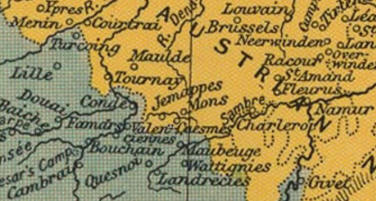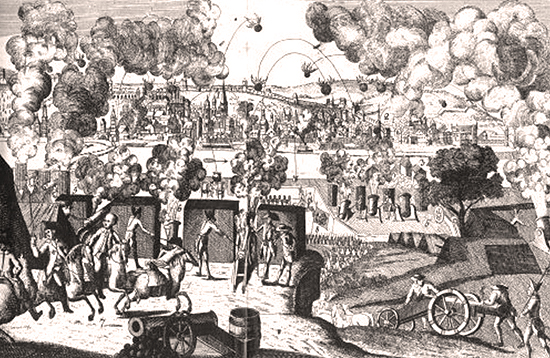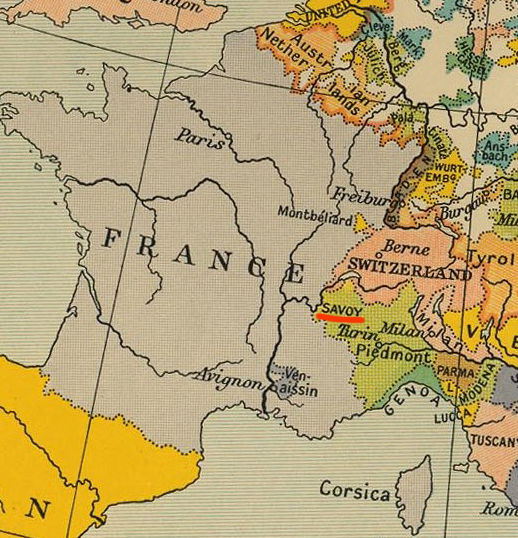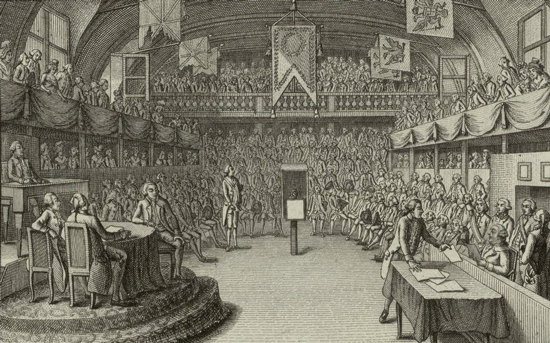|
French
Revolutionary Wars Timeline: 1792
Go here for the
 French Revolutionary Wars
in a Nutshell.
French Revolutionary Wars
in a Nutshell.
February 7, 1792
Holy Roman emperor
 Leopold II and Prussia's king
Leopold II and Prussia's king
 Frederick William II sign a
treaty of alliance.
Frederick William II sign a
treaty of alliance.
March 1, 1792
Holy Roman Emperor
 Leopold II dies at Vienna.
Leopold's son Francis becomes the new Holy Roman Emperor
Leopold II dies at Vienna.
Leopold's son Francis becomes the new Holy Roman Emperor
 Francis II.
Francis II.
March 9, 1792
The new French Defense Minister is
Pierre-Marie de Grave. He succeeds
Louis-Marie-Jacques-Almaric de
Narbonne.
March 16, 1792
Assassination of Swedish king
 Gustav III. He will not
recover.
Gustav III. He will not
recover.
March 20, 1792
The
 Legislative Assembly decrees
the use of the
Legislative Assembly decrees
the use of the
 guillotine.
guillotine.
March 25, 1792
 King Louis XVI approves of the
decree from March 20, 1792, introducing the
King Louis XVI approves of the
decree from March 20, 1792, introducing the
 guillotine. guillotine.
Also on March 25, 1792: France sends
an ultimatum to Austria, advising to disperse all émigrés in their
country, or else.
March 29, 1792
 Gustav III dies.
Gustav III dies.
April 4, 1792
The law number 1606 from April 4, 1792, concerning the French
colonies, states that "Men of color and free negroes are admitted to
vote in every parish assemblies, and are eligible to all places."
Meanwhile the
 Haitian Revolution
is still in full swing on Saint Domingue.
Haitian Revolution
is still in full swing on Saint Domingue.
April 13, 1792
Creation of the
 Army of the Midi. Commander:
Anne Pierre, marquis de Montesquiou-Fezensac.
Army of the Midi. Commander:
Anne Pierre, marquis de Montesquiou-Fezensac.
The French Revolutionary Wars
begin.
The War of the First Coalition begins.
April 20, 1792
France declares war on Austria, who, in turn, allies with Prussia. The
 War of the First Coalition, the
first chapter of the
War of the First Coalition, the
first chapter of the
 French Revolutionary Wars, has
begun.
French Revolutionary Wars, has
begun.
April 25, 1792
The
 guillotine is used for the
first time. Scoundrel Nicolas Jacques Pelletier,
who had killed the person he wanted to rob, was awarded the honor.
guillotine is used for the
first time. Scoundrel Nicolas Jacques Pelletier,
who had killed the person he wanted to rob, was awarded the honor.
April 29, 1792
France invades the Austrian
Netherlands (Belgium) with two armies,
and then retreats.
Armand-Louis de Gontaut, aka the
Duke de
Biron, leads the first
army of 10,000 men to capture Mons,
where Austrian
General Beaulieu was
stationed.
They had set up camp at Quiévrain
the previous night. Now marching
direction Mons, they made it as far
as Boussu, (5 miles or 10 km west of
Mons) where suddenly troops took
flight, screaming "We have been
betrayed."
This was the
Battle
of Mons, also called
the Battle
of Quiévrain.
Another army, led by
General
Théobald Dillon, was
ordered by
General Dumouriez to
capture Tournai to avoid
confrontation.
They march on Tournai but meet
Austrian troops between Lamain and
Marquoin. Skirmish ensues. Following
orders, Dillon commands his men to
retreat. His soldiers thought Dillon
had betrayed them and killed him
back at Lille.
This was the first
Battle of Tournai in
this war. See May 22, 1794, for
more.
And
here is Mons, Tournay, and Lille on
a map:

Map Location
Battles of Mons and Tournai
Click
to enlarge
May 9, 1792
The new French Defense Minister is
Joseph Servan. He succeeds
Pierre-Marie de Grave.
May 18, 1792
Russia invades Poland, thus triggering the
Russo-Polish War of 1792. This war will end with the
Second Partition of Poland on
January 23, 1793.
May 20, 1792
Dr. Antoine Louis, inventor of
the
 guillotine, dies at Paris
after having fallen ill.
guillotine, dies at Paris
after having fallen ill.
June 12, 1792
The new French Defense Minister is
 Charles-Francois Dumouriez. He
succeeds Joseph Servan.
Charles-Francois Dumouriez. He
succeeds Joseph Servan.
June 13, 1792
Recall of the Girondin ministers.
June 16, 1792
The new French Defense Minister is
Pierre-Auguste Lajard. He
succeeds
 Charles-Francois
Dumouriez, who goes to war as commander of the
Army of the North. Charles-Francois
Dumouriez, who goes to war as commander of the
Army of the North.
June 20, 1792
Parisians storm the Tuileries Palace, but this is nothing in
comparison with what will be happening on August 10,
1792.
July 12, 1792
The Assemblee Legislative declares,
Many troops are advancing toward our
borders. All those who hate freedom arm
themselves against our constitution.
Citizens, the country is in danger.
Lafayette, formerly commander of the
 Army of the Center, becomes the
new commander of the
Army of the Center, becomes the
new commander of the
 Army of the North. New
commander of the Army of the Center is Luckner.
Army of the North. New
commander of the Army of the Center is Luckner.
July 21, 1792
Luckner transfers to the Army of the North
because Rochambeau had resigned. Today, Armand-Louis de Gontaut,
duke de Biron is the new commander of the Army of the Rhine.
July 23, 1792
The new French Defense Minister is
Charles-Xavier-Joseph Franquetot
d'Abancourt. He succeeds Pierre-Auguste
Lajard.
July 25, 1792
Brunswick Manifesto (Manifeste
de Brunswick)
This manifesto is a threatening message from the Prussian General
 Charles
William Ferdinand Duke of Brunswick (Karl Wilhelm
Ferdinand von Braunschweig) to the French, advising them to leave
King Louis XVI and his family unharmed, or else. Charles
William Ferdinand Duke of Brunswick (Karl Wilhelm
Ferdinand von Braunschweig) to the French, advising them to leave
King Louis XVI and his family unharmed, or else.
This manifesto was not drafted by
Brunswick himself, and he hesitated to sign it. And rightly so. For
the Parisians, instead of being intimidated, it served as a unifier.
In response to this threat, the French
will feel very patriotic and will accelerate. See August 10, 1792.
July 30, 1792
The
 Duke
of Brunswick
leaves Coblenz with his troops,
expecting to reach Paris before fall. However, his troops will move
much slower than that. Duke
of Brunswick
leaves Coblenz with his troops,
expecting to reach Paris before fall. However, his troops will move
much slower than that.
August 10, 1792
Storming of the Tuileries Palace. Overthrow of the monarchy.
France is now a republic.
Today is perhaps even more important in French history than July 14,
1789 (Storming of the Bastille).
The First
Terror begins. It will end on September 20, 1792. (The
 Reign of Terror is the
Second Terror)
Reign of Terror is the
Second Terror)
August 11, 1792
The new French Defense Minister is the old
Defense Minister Joseph Servan.
He succeeds Charles-Xavier-Joseph
Franquetot d'Abancourt.
August 13, 1792
The royal family is thrown into the Temple prison.
August 18, 1792
 Lafayette
is declared a traitor.
Lafayette
is declared a traitor.
 Dumouriez is the new commander
of the Army of the North (Armée du Nord).
Dumouriez is the new commander
of the Army of the North (Armée du Nord).
August 19, 1792
The
 Duke
of Brunswick
and his troops cross the frontier to
France. Duke
of Brunswick
and his troops cross the frontier to
France.
The
Princess of
Lamballe is transferred
from the Temple prison to the La
Force prison.
In the
night of August 19/20,
 Lafayette
flees the country. But he gets arrested
by the Prussians. They will transfer
him to the Austrians, who will keep
him a prisoner until 1797.
Lafayette
flees the country. But he gets arrested
by the Prussians. They will transfer
him to the Austrians, who will keep
him a prisoner until 1797.
August 23, 1792
The Prussians take Longwy.
September 2, 1792
The Prussians take Verdun.
The
September Massacres
begin. This mass killing of
prisoners is part of the First
Terror and will last until September
6, 1792.
Moreton-Chabrillant is the new
commander of the Army of the North.
His post is temporary.
September 3, 1792
The Princess of Lamballe
(Marie-Thérèse Louise de
Savoie-Carignan) one of
Marie-Antoinette's closest friends,
is snatched from prison and lynched
by the mob, and her head carried on
a pike in front of the latter's
window.
September 6, 1792
The September Massacres end. All in all, about 1,200
prisoners were killed by the mob.
These massacres had started on
September 2, 1792.
September 20, 1792
French victory at the
 Battle of Valmy.
The French, led by Battle of Valmy.
The French, led by
 Charles-François Dumouriez
and
François-Christophe Kellermann,
fight against invading Prussians and
Austrians.
Charles-François Dumouriez
and
François-Christophe Kellermann,
fight against invading Prussians and
Austrians.
The
First
Terror ends. It had begun
on August 10, 1792. (The
 Reign of
Terror is the
Second Terror)
Reign of
Terror is the
Second Terror)
September 21, 1792
Formal abolition of the monarchy. Today, the proclamation
from August 10, 1792 is legally
confirmed.
The
 Legislative
Assembly is replaced
by the
Legislative
Assembly is replaced
by the
 National
Convention.
National
Convention.
September 22, 1792
Proclamation of the Republic.
First day of the
 French Republican Calendar.
French Republican Calendar.
Today is 1 Vendémiaire, year I. But people don't know it yet because
the French Republican Calendar won't
be official until October 5, 1793,
when it will be implemented
retroactively.
Sometime between today and November
1792,
Marianne becomes the name
for the French Republic. Today,
therefore, is her birthday, if you
will. In pictures, she appears most
of the time wearing a Phrygian cap,
aka the cap of liberty. The French
kept her on their government logo to
this day.

Marianne
Heading Liberté, Egalité,
and Fraternité
September 25, 1792
The Convention decrees that "the
Republic is one and inseparable."
September 28, 1792
La
Bourdonnaye is the new
commander of the
 Army of the
North.
Army of the
North.
September 29, 1792
D'Anselme
calls his right wing of the Army of
the Midi,
 Army of the
Var. The name will
stick.
Army of the
Var. The name will
stick.
September 30, 1792
Battle of
Spires.
also spelled Speyer, French victory, led by
 General
Custine. 20,000
French troops against 12,000
Austrians. The French take 2,900
prisoners. The Austrians surrender.
General
Custine. 20,000
French troops against 12,000
Austrians. The French take 2,900
prisoners. The Austrians surrender.
October 1, 1792
The right wing of the Army of the North becomes the
 Army of the
Ardennes. Commander:
Army of the
Ardennes. Commander:
 Dumouriez.
Formerly, it had been the right wing
of the Army of the North.
Dumouriez.
Formerly, it had been the right wing
of the Army of the North.
The left wing of the Army of the
Rhine becomes the
 Army of the
Moselle. Commander:
Kellermann.
Army of the
Moselle. Commander:
Kellermann.
Creation of the
 Army of the
Interior. Commander:
Berruyer.
Army of the
Interior. Commander:
Berruyer.
Creation of the
 Army of the
Pyrenees. Commander:
Servan.
Army of the
Pyrenees. Commander:
Servan.
Creation of the
 Army of the
Vosges. Commander:
Custine.
Army of the
Vosges. Commander:
Custine.
October 4, 1792
The French, led by
 General
Custine
march on Worms and the
city immediately surrenders.
General
Custine
march on Worms and the
city immediately surrenders.
October 8, 1792
The Prussians abandon Verdun.
October 18, 1792
The new French Defense Minister is
Jean-Nicolas Pache. He
succeeds
Joseph Servan.
October 19, 1792
The French besiege Mainz (Mayence).
October 21, 1792
Having been besieged since October
19, 1792, the city of Mayence
(Mainz) surrenders to the French, led by
 General
Custine.
General
Custine.

Bombardment of Mainz (Mayence) — October 1792
Contemporary engraving by unknown
artist
October 22, 1792
The French, led by
 General
Custine
take Frankfurt.
General
Custine
take Frankfurt.
The
Prussians abandon Longwy.
November 3, 1792
The French, led by
 General
Dumouriez
invade the Austrian Netherlands.
General
Dumouriez
invade the Austrian Netherlands.
November 6, 1792
 Battle of Jemappes.
French victory. Battle of Jemappes.
French victory.
November 13, 1792
The French take Brussels.
November 16, 1792
A French warship enters Ostend
(Oostende, Ostende) without
resistance.
November 17, 1792
The French take Malines (Mechelen.)
November 19, 1792
After the massacres of September and
some victories in the war, the
Convention declares that "it will
grant fraternity and assistance to
all people who want to regain their
freedom."
November 20, 1792
Discovery of the famous iron chest
at the Tuileries. A trial of Louis
XVI becomes inevitable.
November 27, 1792
The French take Liège (Luik, Lüttich.)
The
National Convention declares the
annexation of Savoy (Savoie). In
December it will become the
département du Mont-Blanc.

Map Location of Savoy (Savoie) 1792
Click
to enlarge
November 29, 1792
Antwerp surrenders to the French.
December 2, 1792
Namur surrenders to the French.
Battle of
Frankfurt. The Prussians
and Hessians recapture Frankfurt
from French
 General
Custine and his men. General
Custine and his men.
The
 Army of the
Midi (Army of the
South) is split into the
Army of the
Midi (Army of the
South) is split into the
 Army of the
Alps (Commander:
Kellermann)
and the
Army of the
Alps (Commander:
Kellermann)
and the
 Army of Italy
(Commander:
Anselme).
Army of Italy
(Commander:
Anselme).
D'Anselme and his " Army of the
Var" (officially the
right wing of the Army of the Midi)
become the Army of Italy.
Army of the
Var" (officially the
right wing of the Army of the Midi)
become the Army of Italy.
December 3, 1792
Louis XVI is incarcerated since
August 13, 1792. What to do with
him?
Robespierre speaks before the National Convention:
Neither prison nor exile can make public
happiness indifferent to the existence of a
dethroned king [...], a king whose name
alone attracts the scourge of war on an
agitated nation. [...]
I state with regret the fatal truth: Louis
must die, because the country must live.
The National Convention decrees that
Louis XVI shall be tried by the
National Convention.
December 10, 1792
 General
Dumouriez
is again the commander of the
General
Dumouriez
is again the commander of the
 Army
of the North. He also has the
command over the Army of the
Ardennes.
Army
of the North. He also has the
command over the Army of the
Ardennes.
The trial of the citizen Louis Capet
(King Louis XVI) begins.
Technically, it is still Louis XVI
rather than Louis Capet, because of
the Constitution from September 3,
1791. Either way, Louis' formal
indictment lists 33 crimes.
December 11, 1792
Louis appears at his trial. His charges are read. Louis is
interrogated by
Barère,
and has to respond to and justify
each one of them.
December 12, 1792
Louis is granted a conseil de défense. Members of this
legal counsel are
François
Denis Tronchet, former
president of the bar association,
Chrétien-Guillaume de Lamoignon de
Malesherbes, two times a
minister, and
Raymond de Sèze,
former judge and lawyer.
December 15, 1792
The French take Aachen
(Aix-la-Chapelle.)
December 25, 1792
 Louis XVI
signs his
Louis XVI
signs his
 Last Will
Last Will
December 26, 1792
Louis presents his defense.
By speaking perhaps for the last time, I
declare that my conscience does not reproach
me, and that my defense counsel has told you
the truth.
This is the second and last time
that Louis personally appears at his
trial. Louis' lawyers respond and
plead not guilty on all 33 counts.

Louis XVI at His Trial Before the
National Convention on December 26, 1792
Louis
XVI a la Convention nationale le 26
décembre 1792
Engraving by Pierre Adrien Le Beau,
1793
Bibliothèque nationale de France
December 27, 1792
New commander of the
 Army of Italy:
Brunet
(temp)
Army of Italy:
Brunet
(temp)
December 30, 1792
Valence is the new
commander of the
 Army of the
Ardennes, but still
under
Army of the
Ardennes, but still
under
 General
Dumouriez
(Army of the North, see December 10,
1792).
General
Dumouriez
(Army of the North, see December 10,
1792).
More History
|